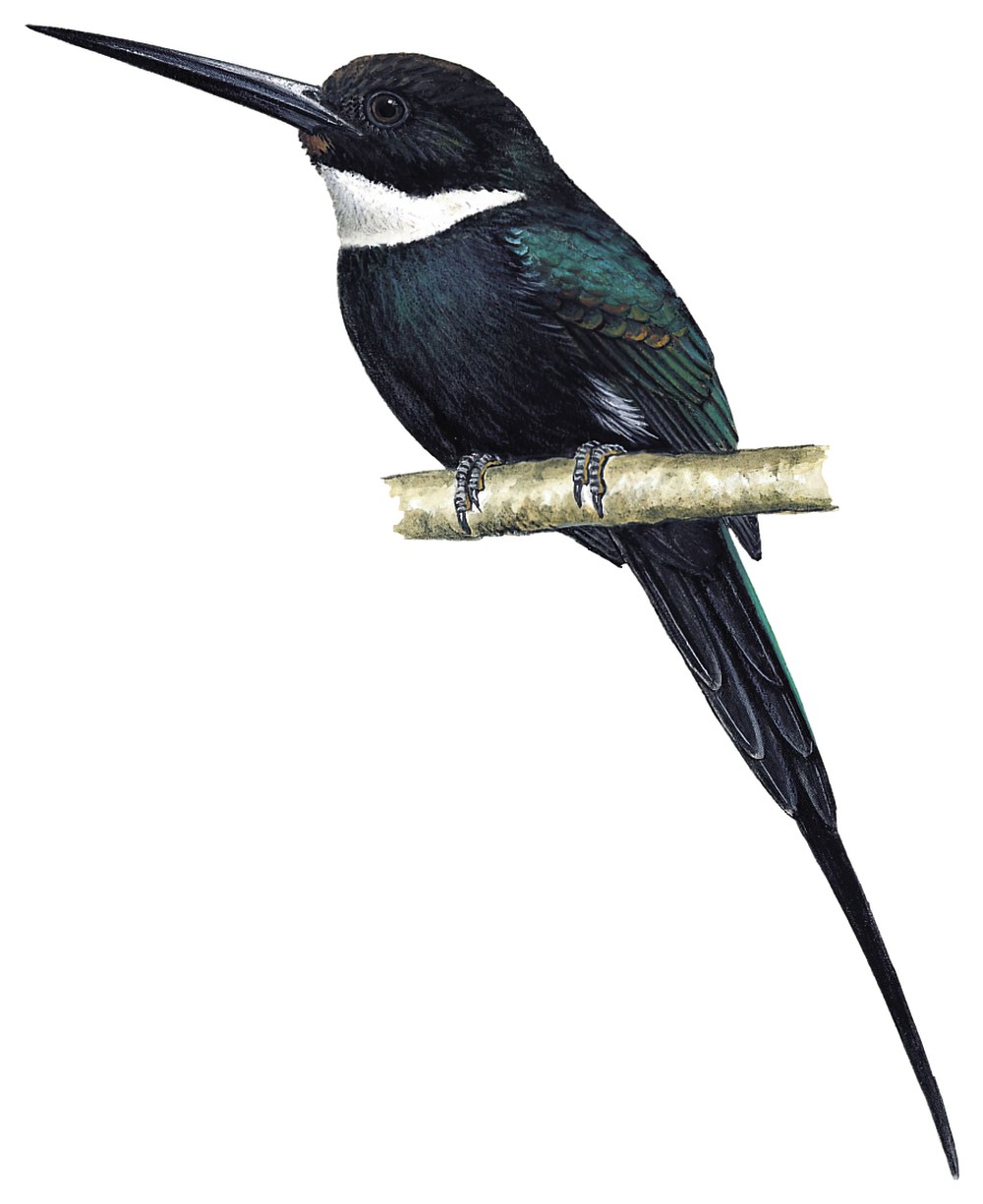Paradise Jacamar / Galbula dea

Paradise Jacamar
SCI Name:
Protonym: Alcedo Dea Syst.Nat.ed.10 p.116
Taxonomy: Galbuliformes / Galbulidae / Galbula
Taxonomy Code: parjac1
Type Locality: Surinam.
Author: Linnaeus
Publish Year: 1758
IUCN Status: Least Concern
DEFINITIONS
GALBULA
(Galbulidae; † Green-tailed Jacamar G. galbula) L. galbulus small yellowish bird, subsequently identified as a type of ‘woodpecker’ that builds a pendulous nest, and thus associated with the Golden Oriole < dim. galbina small yellow bird < galbus oriole, yellow; "Le nom de galbula, transporté à ce genre, désignait chez les Latins le loriot [Oriolus]" (Lesson 1830); "Galbula. Genus 48. ... Le genre du Jacamar (1) ... (1) Jacamar, nom formé de Jacamaciri, qui est celui que les Brasiliens donnent à la premiere espece de ce genre ... Genus Galbulæ (1) ... (1) Galbula, nomen primæ hujus generis speciei a Moehringio inditum" (Brisson 1760): based on "Jacamaciri" of Marcgrave 1648, and Piso 1658, "Picus Brasiliensis" of Klein 1750, and "Galbula" of Moehring 1752; "Galbula Brisson, Orn., 1, 1760, p. 42; 4, p. 86. Type, by tautonymy, Galbula = Alcedo galbula Linné." (Peters, 1948, VI, p. 5).
Synon. Auga, Caucalias, Chalcophanes, Psilopornis, Urocex, Urogalba.
• (Oriolidae; syn. Oriolus † European Golden Oriole O. oriolus) Specific name Oriolus galbula Linnaeus, 1766 (= syn. Oriolus oriolus); "*393. GALBVLA. WILLVGS. Rostrum rectum, attenuatum, subtetragonum. Lingua brevis. Digiti antici tres. ORIOLVS Galbula LINN." (Scopoli 1777); "Galbula "Willughby" Scopoli, 1777, Introductio ad Historiam Naturalem, p. 480. Type, by monotypy and tautonymy, Oriolus galbula Linnaeus, 1766 = Coracias oriolus Linnaeus, 1758." (JAJ 2021).
Var. Galbulus.
galbula
L. galbulus small yellowish bird, subsequently identified as a type of ‘woodpecker’ that builds a pendulous nest, and thus associated with the Golden Oriole < dim. galbina small yellow bird < galbus oriole, yellow.
● ex “Jacamaciri of Marcgrave” of Edwards 1751 (Galbula).
● “This gold-coloured bird I have only seen in Virginia and Maryland ... It is said to have its name from the Lord Baltimore’s Coat of Arms ... his Lordship being a proprietor in those countries ... Its nest is built in a particular manner, supported only by two twigs fixed to the verge of the nest, and hanging most commonly at the extremity of a bough” (Catesby 1731); 49. CORACIAS. ... Galbula. 4. C. fulva, capite dorso remigibusque nigris. Icterus ex aureo nigroque varius. Catesb. car. I. p. 48. t. 48. Habitat in America." (Linnaeus 1758) (Icterus).
dea
L. dea goddess < deus god.
● "56. ALCEDO. ... Dea. 7. A. rectricibus duabus longissimis, corpore nigro-cærulescente, alis virescentibus. Alcedo binis plumis in cauda longissimis. Edw. av. 10. t. 10. Avis paradisiaca ternatana. Seba. mus. I. p. 74. t. 46. f. 3? Habitat Surinami." (Linnaeus 1758) (Galbula).
● ex "Avis Paradisiaca Ternatana" of Seba 1735, "Pica Ternatana" of Klein 1750, and "Martin-Pescheur de Ternate. Ispida Ternatana" of Brisson 1760 (syn. Tanysiptera nais).
SUBSPECIES
Paradise Jacamar (dea)
SCI Name: Galbula dea dea
dea
L. dea goddess < deus god.
● "56. ALCEDO. ... Dea. 7. A. rectricibus duabus longissimis, corpore nigro-cærulescente, alis virescentibus. Alcedo binis plumis in cauda longissimis. Edw. av. 10. t. 10. Avis paradisiaca ternatana. Seba. mus. I. p. 74. t. 46. f. 3? Habitat Surinami." (Linnaeus 1758) (Galbula).
● ex "Avis Paradisiaca Ternatana" of Seba 1735, "Pica Ternatana" of Klein 1750, and "Martin-Pescheur de Ternate. Ispida Ternatana" of Brisson 1760 (syn. Tanysiptera nais).
Paradise Jacamar (amazonum)
SCI Name: Galbula dea amazonum
amazonius / amazonum / amazonus
Mod. L. Amazonus Amazonian, of Amazonia.
Paradise Jacamar (brunneiceps)
SCI Name: Galbula dea brunneiceps
brunneiceps
Mod. L. brunneus brown < Med. L. brunius brown; L. –ceps -crowned < caput, capitis head.
Paradise Jacamar (phainopepla)
SCI Name: Galbula dea phainopepla
PHAINOPEPLA
(Ptiliogonatidae; Ϯ Phainopepla P. nitens) Gr. φαεινος phaeinos brilliant, shining < φαινω phainō to shine; πεπλος peplos cloak; "CICHLOPSIS NITENS, Bd. 320. — Mr. Sclater writes that the type of Cichlopsis (Turdus leucogonys of Berlin Museum) is very different from Ptilogonys nitens, Sw. He proposes for the latter the generic name of Phainopepla, Sclater." (Baird 1858); "For the Ptilogonys nitens of Swainson, erroneously referred to this genus [Cichlopsis] by Baird, I propose the generic name Phainopepla φαεινος, nitidus, et πεπλος, vestis." (P. Sclater 1859); "Phainopepla Baird, 1858, in Baird, Cassin and Lawrence, Rep. Expl. and Survey R. R. Pac., 9, p. xix, xxxiv, 923. Type, by original designation, Phainopepla nitens Swainson (credited to Sclater)." (Greenway in Peters 1960, IX, 372). The Phainopepla or Black Silky-flycatcher shows plumage traits very distinct from other members of the family.
Var. Phaenopepla ("I notice that in Coues's 'Key,' Baird, Brewer, and Ridgway's 'North-American Birds,' and in other American works lately issued, the generic term "Phainopepla," which I proposed in 1858 for the Ptilogonys nitens of Swainson, is altered into "Phænopepla." I wish to point out that this "emendation" of my spelling is incorrect. The derivation of "Phainopepla," as was given when the name was made (P. Z. S. 1858, p. 453), is φαεινος, nitidus, and πεπλον, vestis. Now φαεινος in Latin becomes "Phainus," not "Phænus," and Phainopepla is orthographically right. "Phainoptila" of Salvin (1877) is derived from the same word. I hope no one will try to emend it." (P. Sclater 1879)).
Synon. Lepturus.
UPPERCASE: current genus
Uppercase first letter: generic synonym
● and ● See: generic homonyms
lowercase: species and subspecies
●: early names, variants, mispellings
‡: extinct
†: type species
Gr.: ancient Greek
L.: Latin
<: derived from
syn: synonym of
/: separates historical and modern geographic names
ex: based on
TL: type locality
OD: original diagnosis (genus) or original description (species)












